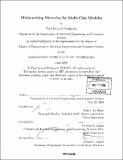Miniaturizing microvias for multi-chip modules
Author(s)
Puskarich, Paul Gerard
DownloadFull printable version (66.00Mb)
Other Contributors
Massachusetts Institute of Technology. Dept. of Electrical Engineering and Computer Science.
Advisor
John J. Le Blanc and Thomas W. Eagar.
Terms of use
Metadata
Show full item recordAbstract
Electronics packaging is continually migrating toward denser packaging. This encompasses a push toward multilevel die, denser metallization, and smaller microvias. In this thesis we investigate the miniaturization of laser-drilled microvias in polyimide dielectric for chips-first multi-chip module (MCM) technology. The challenge is to produce increasingly smaller microvias and package more microvias into a given area without sacrificing electrical performance. Principally, this means a microvia must maintain certain minimum electrical resistance and mechanical adhesion to the conducting layers. The thesis encompasses the following research: 1. Investigating the state of the art in laser-drilled polyimide microvias. 2. Designing and fabricating test structures with microvias, in which the state of the art is pushed in microvia size and/or aspect ratio. 3. Measuring the contact resistances of laser-drilled microvias in a Kelvin structure configuration. 4. Developing finite element models of Kelvin structures to estimate the contact resistance of miniature microvias.The experimental results of this thesis prove that microvias with approximately 19 pm diameter and 10 mQ contact resistance can be reliably fabricated for chips-first MCM technology.
Description
Thesis (M. Eng.)--Massachusetts Institute of Technology, Dept. of Electrical Engineering and Computer Science, 2008. Includes bibliographical references (p. 63-64).
Date issued
2008Department
Massachusetts Institute of Technology. Department of Electrical Engineering and Computer SciencePublisher
Massachusetts Institute of Technology
Keywords
Electrical Engineering and Computer Science.